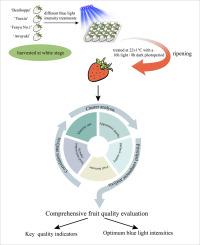蓝光作为采后工具:强度依赖性增强的成熟,质量,和货架期潜力在分离草莓
IF 8.2
1区 农林科学
Q1 CHEMISTRY, APPLIED
引用次数: 0
摘要
草莓作为一种重要的经济作物,提高果实品质和延长采后保质期一直是草莓生产研究的重点。研究了蓝光强度对4个基因型草莓(Fragaria × ananassa Duch.)白期果实成熟和品质的影响。所有基因型均在3 ~ 4 d内成熟。生理分析表明,BL处理促进果实着色,调节激素协同作用加速成熟,改善内在品质指标,最有效地提高了总抗氧化能力。然而,结果因基因型和光照强度而有显著差异,光照强度过高会抑制品质改善。在所有处理中,200 μmol m−2 s−1蓝光对大多数基因型(‘Benihoppe’、‘Fenyu 1号’)的品质增强效果最佳。研究结果为草莓生产中优化灌浆强度奠定了理论基础,并验证了灌浆强度优化的现实可行性,同时提出了灌浆条件下提前采收作为延长草莓货架期的新策略。本文章由计算机程序翻译,如有差异,请以英文原文为准。

Blue light as a postharvest tool: Intensity-dependent enhancement of ripening, quality, and shelf-life potential in detached strawberries
As a vital economic crop, enhancing fruit quality and extending postharvest shelf-life remain central research priorities in strawberry production. This study investigated the effects of blue light (BL) intensity on ripening and quality of four strawberry (Fragaria × ananassa Duch.) genotypes harvested at the white stage. All genotypes under BL treatment reached full maturity within 3–4 d. Physiological analyses revealed that BL treatment promoted fruit coloration, regulated hormonal synergies to accelerate ripening, improved intrinsic quality indices, and most effectively enhanced total antioxidant capacity. However, outcomes varied significantly with genotype and light intensity, with excessive intensity suppressing quality improvement. Among all treatments, 200 μmol m−2 s−1 blue light demonstrated optimal efficacy for quality enhancement in most genotypes (‘Benihoppe’, ‘Fenyu No.1’). These results establish a theoretical foundation for optimizing BL intensity in strawberry production and validate its practical feasibility, while proposing early harvesting under BL as a novel strategy for shelf-life extension.
求助全文
通过发布文献求助,成功后即可免费获取论文全文。
去求助
来源期刊

Food Chemistry: X
CHEMISTRY, APPLIED-
CiteScore
4.90
自引率
6.60%
发文量
315
审稿时长
55 days
期刊介绍:
Food Chemistry: X, one of three Open Access companion journals to Food Chemistry, follows the same aims, scope, and peer-review process. It focuses on papers advancing food and biochemistry or analytical methods, prioritizing research novelty. Manuscript evaluation considers novelty, scientific rigor, field advancement, and reader interest. Excluded are studies on food molecular sciences or disease cure/prevention. Topics include food component chemistry, bioactives, processing effects, additives, contaminants, and analytical methods. The journal welcome Analytical Papers addressing food microbiology, sensory aspects, and more, emphasizing new methods with robust validation and applicability to diverse foods or regions.
 求助内容:
求助内容: 应助结果提醒方式:
应助结果提醒方式:


